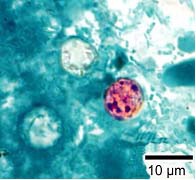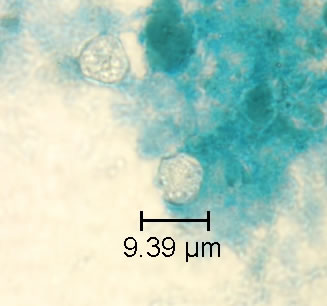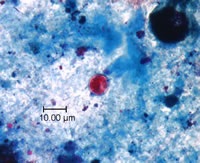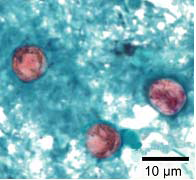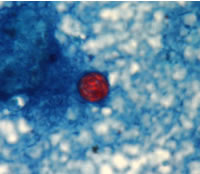Cyclosporiasis laboratory findings
|
Cyclosporiasis Microchapters |
|
Diagnosis |
|---|
|
Treatment |
|
Case Studies |
|
Cyclosporiasis laboratory findings On the Web |
|
American Roentgen Ray Society Images of Cyclosporiasis laboratory findings |
|
Risk calculators and risk factors for Cyclosporiasis laboratory findings |
Editor-In-Chief: C. Michael Gibson, M.S., M.D. [1]
Overview
Health care providers should consider Cyclospora as a potential cause of prolonged diarrhea, particularly in patients with a history of recent travel to Cyclospora endemic areas. Testing for Cyclospora is not routinely done in most U.S. laboratories, even when stool is tested for parasites. Therefore, if indicated, health care providers should specifically request testing for Cyclospora. Cyclospora infection is diagnosed by examining stool specimens. Diagnosis can be difficult in part because even persons who are symptomatic might not shed enough oocysts in their stool to be readily detectable by laboratory examinations. Therefore, patients might need to submit several specimens collected on different days. Special techniques, such as acid-fast staining, are often used to make Cyclospora oocysts more visible under the microscope. In addition, Cyclospora oocysts are autofluorescent, meaning that when stool containing the parasite is viewed under an ultraviolet (UV) fluorescence microscope the parasite appears blue or green against a black background. Molecular diagnostic methods, such as polymerase chain reaction (PCR) analysis, are used to look for the parasite's DNA in the stool.[1]
Laboratory Findings
Stool Examination
Wet Mount
In bright-field microscopy using differential interference contrast (DIC), oocysts appear as refractile spheres (8 to 10 μm) with a distinct oocyst wall, but may be confused with other objects. Under UV fluorescence microscopy, the oocyst wall autofluoresces. An intense blue fluorescence is obtained with the preferred UV excitation filter set (330 to 365 nm). If this filter set is not available, a less intense green fluorescence can be obtained with blue excitation (450 to 490 nm). Other objects, however, can also autofluoresce. A fluorescence microscope is required and this procedure does not provide a stained slide that can be archived.Both DIC and UV fluorescence microscopy are efficient and reliable approaches for identification of this coccidian. Objects found by UV microscopy should always be checked under DIC and vice versa.
Shown below is an image of oocyst of cyclospora under UV fluorescence microscopy and differential interference contrast
Modified Acid Fast Stain
A blue-green background, or contrasting counterstain, of fecal debris allows the oocysts to stand out. The oocysts are variably stained: some will stain light pink to deep purple, while others may be unstained. The oocysts (8 to 10 μm) may not be perfectly round; some may appear collapsed or distorted on one side. They may contain granules and/or have a wrinkled oocyst wall appearance (characteristics that distinguish oocysts from acid-fast artifacts). This staining method is the easiest and most practical, and provides a stained slide that can be archived. Misdiagnosis can result, however, due to the variability in staining and confusion with artifacts.
Shown below are images of oocysts of cyclospora stained with modified acid fast stain.
Safranin Stain
Oocysts stain uniformly, red to reddish-orange. This uniform staining decreases the risk of misdiagnosis. However, this technique requires heating, therefore additional equipment is necessary (e.g., microwave oven).
Shown below are images of oocysts of cyclospora stained with safranin stain.
Trichrome Stain
Oocysts may be detected, but should not be confirmed, by this method. Because trichrome stain is the routine staining technique for stool specimens in most laboratories, laboratorians should be familiar with the appearance of Cyclospora stained with trichrome in order to detect oocysts during routine ex-aminations. However, this staining method is inadequate for definitive diagnosis because all oocysts will appear unstained. Oocysts appear as clear, round, and somewhat wrinkled spheres (8 to 10 μm). The diagnostic techniques listed above should be used to confirm Cyclospora when the presence of this coccidian is suspected in a trichrome stained smear.[2]/cyclospora_benchaid.pdf
Polymerase Chain Reaction
Molecular diagnostic methods, such as polymerase chain reaction (PCR) analysis, are used to look for the parasite's DNA in the stool.[3]


